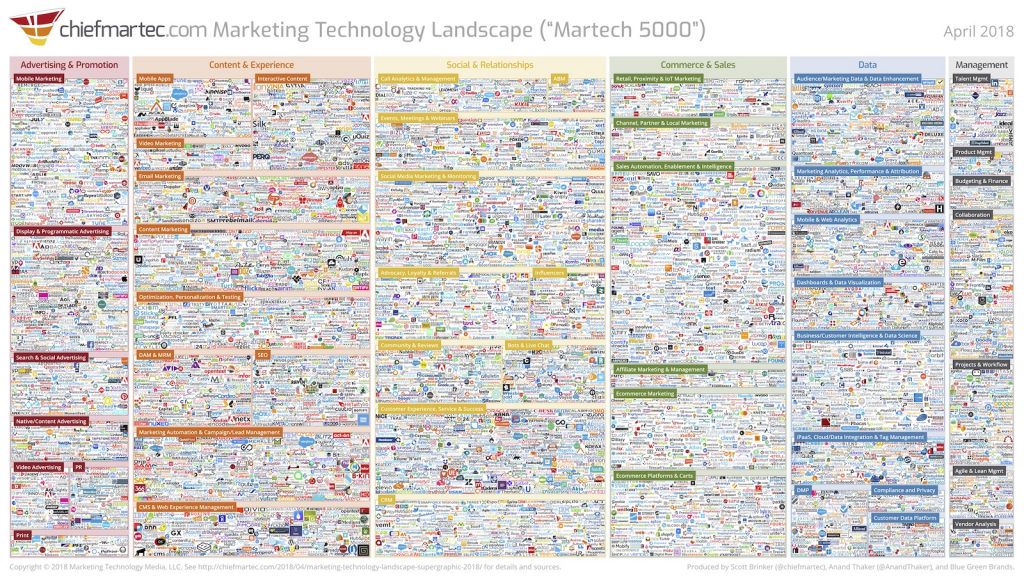It’s hard to believe Scott Brinker’s legendary marketing technology landscape had just 150 players in 2011. Today, there are over 6,800 — all offering a different tool, feature, measurement capability, or platform integration. While daunting, there is a silver lining to this chaotic tangle of solutions: Every one of them represents an opportunity for marketers to work smarter, not harder.
In this blog post, we’ll share how marketers are streamlining their efforts more than ever while driving better engagement, using measurement to make more impactful decisions, and reaching customers anytime and anywhere.
Use Artificial Intelligence
With consumers using their phones to shop, talk, selfie, or just about anything else, there has never been more data for marketers to sift through. AI offers marketers the opportunity to analyze massive amounts of customer data and get a clearer, more accurate look into customer needs.

Photo credit: MobileMarketer.com
AI frees marketers from doing all the things, all the time, by letting them hand off automatable tasks to computers. Take Domino’s, for example, which is testing out Dom, an AI voice-ordering assistant. Dom can take orders and check order statuses for customers over the phone, freeing up Dominos employees to focus on making pizzas and handling in-store transactions. By taking over even a couple simple tasks, AI can increase accuracy and efficiency, decrease costs, and lower stress.
AI is also helping marketers create personalized customer experiences beyond what’s capable with standard segmentation. If you’ve ever mapped your customer journey, you know it can easily become a web of buyer personas, channels, flows, needs, devices, locations, and other details. AI effortlessly sifts through the data and patterns of customer behavior, allowing marketers to be more accurate in their understanding of the customer, and deliver the right message at the right time.
Automate Everything (Even Mobile)
Mobile is no longer a single channel or an isolated marketing strategy. Mobile is marketing. As such, marketers are using mobile automation platforms that connect to the rest of their marketing automation platforms — or, better yet, a system that measures across mobile and beyond in one platform. (Sound familiar?)
A multichannel automation solution enables marketers to do their job more quickly and effectively by aggregating and connecting everything you need to run and analyze campaigns, all in one place. And that enables marketers to deliver a better, more unified experience to their customers, which increases engagement and conversion … which increases lifetime value … which increases revenue …
Market in the Moment
According to The Forrester Wave™: Mobile Engagement Automation Q3 2017, the next focus area for marketers to win, serve, and retain consumers is “in the moment.” That means delivering personalized content when a customer expects it. Of course, mobile is essential for making that happen. For the most success, Forrester recommends marketers take advantage of data integration, audience creation and management, campaign and moment orchestration tools, and behavioral and campaign analytics tools.
Get Personal With Emotional Analytics
Whereas click-through rates used to be a sufficient measure of customer interest, the playing field has changed. Marketers are discovering new ways to measure their audience’s affinity for brands and services. Facial recognition, voice analysis, emotional metrics, and other behavior analysis tools are being used to measure the sentiments and emotions of customers across touchpoints, including social media. Marketers can use AI to analyze emotion and demographics, then segment customers and deliver highly-targeted marketing based on who is likely to buy now, buy in the future, or who never will.
For example, EasyJet used emotional analytics to discover what customers felt about previous trips they had taken. Then, EasyJet sent customers personalized emails featuring their individual travel history with the airline. The emails were opened twice as much as EasyJet’s normal email campaigns, and the most common word recipients used to describe the campaign was “love.”

Photo credit: Econsultancy.com
Look Into the Future
Ultimately, the future of marketing comes down to more relevant, responsive, and personalized marketing. And the only way for marketers to be able to deliver better experiences — and at scale— is to work smarter, not harder. That’s where leveraging technology like AI comes in, along with getting deeper, more actionable insights into customer analytics, and uniting your omnichannel marketing.
To hear what TUNE’s up to and how we make life easier for marketers, get in touch.
Author
Becky is the Senior Content Marketing Manager at TUNE. Before TUNE, she handled content strategy and marketing communications at several tech startups in the Bay Area. Becky received her bachelor's degree in English from Wake Forest University. After a decade in San Francisco and Seattle, she has returned home to Charleston, SC, where you can find her strolling through Hampton Park with her pup and enjoying the simple things between adventures with friends and family.





Leave a Reply
You must be logged in to post a comment.